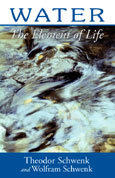Theodor Schwenk, Wolfram Schwenk – WATER The Element of Life
 It is the living movement of water that makes life on Earth possible. Based on spiritual science and on their own numerous experiments, Theodor and Wolfram Schwenk show that our Earth is a living organism, with water as a sensory organ that perceives vital cosmic influences and transmits them into earthly life. This pioneering classic on water is more relevant now than ever before.
It is the living movement of water that makes life on Earth possible. Based on spiritual science and on their own numerous experiments, Theodor and Wolfram Schwenk show that our Earth is a living organism, with water as a sensory organ that perceives vital cosmic influences and transmits them into earthly life. This pioneering classic on water is more relevant now than ever before.
http://www.rudolfsteinerpress.com/pages/viewbook.php?isbn_in=9780880102773




 Is there a secret language all around us? What’s so special about the shape of the Great Pyramid? How can there be something sixy about circles?
Is there a secret language all around us? What’s so special about the shape of the Great Pyramid? How can there be something sixy about circles? An Introduction to Modern Geometry
An Introduction to Modern Geometry